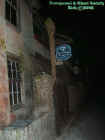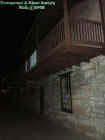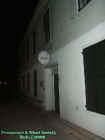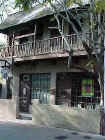|
|
||
|
St. Augustine Florida is the oldest city in the nation. With almost 500 years of history it would be no wonder as to why the downtown streets have ghost tales as well as tragedies told. The city of St. Augustine's existed 42 years before the English colonized Jamestown and 55 years before the pilgrims landed at Plymouth Rock. St. Augustine was the first settlement and was established by the Spanish. Today even if you were to walk down the cobble stone narrow streets, through the various courtyards and gardens you would see a reflection of Spanish Architecture throughout the city. Today there is thirty-six buildings of colonial origin near the Spanish Quarter Village and another forty that are reconstructed models of colonial structures. The city was laid about by Governor Gonzalo Mendez de Canzo. The city has survived massacres, hurricanes, fires, plagues and now today I am able to bring you this special series of investigations as we cautiously roam the historical streets of one of the most haunted cities in the nation. I first off would like to talk about the timeline of events throughout St. Augustine at least so you can understand how historical this city really is. Often when people visit here they admire all the old structures and tours but you really cannot appreciate it till you understand the past that had to be endured and the fact that what this city had to overcome to even exist today. The city of St. Augustine was named in honor of the saint whose feast day fell on the day Pedro Menendez sited shore. He was sent from King Phillip with over 600 voyagers to claim Florida as Spanish colony. Menedez with the help of a hurricane and confrontation of the French Garrison at the mouth of St. Johns conquered the fleet from Fort Caroline which Spain called a menace to there attempt to claim Florida as there own. Then proceeded to the south of the St. Johns River Mouth where the battle took place. The confrontation between Menedez was a horrible massacre as after the battle was won he took over 140 men prisoner and had them all executed sparing only the children as well as the women. After this they captured Fort Caroline which was full of French Protestants known as Huguenots. The fort was named Fort San Mateo but this was not the first Spanish Settlement though. Forty Five Frenchmen had escaped at the time the fort was being invaded there were French ships in the Matanzas Inlet. Trapped with nowhere to go a hurricane destroyed the fleet. The men were beached on St. Augustine Shores this is when Menedez caught them by surprise slaughtering 250 men only to claim the Matanzas Inlet for Spain. The Spanish Explorer Menedez perhaps was also the inquisition and slaughtered anybody who defied him in his quest for Florida. Men cheered after their victory which would eventually be the place of St. Augustine. St. Augustine would established as a military base which would protect Florida and the city would serve as a Catholic missionary. The city would serve as a guard for Spanish Treasure ships traveling from the Gulf Stream back to Spain. That was one of the reasons for Menedez journey was to fight the French off from them interfering with Spanish Treasure ships. Also Spain was a Catholic country merely trying to expand its godly views and spread its faith upon the Indians. It was not easy settling in St. Augustine the Timucuan Indians often were hostile and although curiously watching brutal attacks did take place. Before Menedez set foot onto the St. Augustine shores in 1513 Juan Ponce DeLeon visited the Fountain of Youth which is also near the city of St. Augustine. But Deleon wanted to claim Florida all Menedez did was secured Spain's Ownership of Florida doing so with establishing St. Augustine. In June of 1586 an English pirate named Sir Francis Drake attacked the settlement with 2,000 pirates. He burnt the wooden fort down and the village. I believe during this invasion he had received news that the fort was abandoned so he made his move. He took 2,000 pounds of sterling and some bronze artillery upon capturing the town. Juan Fernandez a black Spanish Soldier with his native American allies created a diversion to stall Drakes troops and most of the towns people escaped into the swamps. Drake voyaged back to England leaving 15 men in St. Augustine and its fort. A year later those men turned up dead since they were pirates its possible those men are the ones rumored to be buried behind the lighthouse. The colonist eventually came back to reestablish St. Augustine in 1587. St. Augustine was eventually rebuilt but only a little over 10 years later in 1599 a hurricane and fire destroyed the city. The third governor rebuilt the city this time with a plaza and guardhouse, warehouse treasury, and governors house. The fire destroyed the La Soledad, Parish Church and many Spanish Homes. A swamp which once existed in the city was drained and removed by Canzo. From the later 1500s all the way to the later 1600s St. Augustine would have face great hardships. In the 1600s Smallpox, yellow fever and measles came to Florida probably killing 100s of settlers. Many English Pirates attacked the town, fires occurred and some of the worst hurricanes in Florida history. One hurricane in 1622 caused a great flood within the city. St. Augustine was consistently being attacked by the English and Pirates. With them having settlements in Georgia and the Carolinas there was a conflict of interest. Then in 1668 Captain John Davis an English Freebooter pillaged the town killing over 60 settlers. With all of the attacks and hardships a fort was built called the Castillo De San Marcos late in the later 17th century after that St. Augustine would not fall ever again. It was the largest stone fort in the country and we also investigated it so please refer to that investigation to learn more about the history of it because it even has a history of its own which perhaps shaped the future of St. Augustine. Then in 1702 a two month siege occurred when the British troops burned down the town. All the villagers fled and held out for two months within the fort. The British attack came from the Carolinas from Governor James Moore and at the time 31 houses were destroyed to stall the raid of 1702. Despite the efforts from the Spanish commander to deflect the raid it had failed and the English burned the rest of the town which was 118 other structures mainly on St. George Street named after King George II an area where we focused alot of our investigation. At that time however it was called San Patricio Street. Since the British were unable to take the town after a two month siege they withdrew hence the burning of the town. Then in 1740 a stronger attack was mounted by the Governor of the British colony of Georgia constructed by General James Oglethorpe which was another failed attempt to capture the fort. This eventually lend to the land gate and wall which at one time surrounded St. Augustine. The land gate today is the Old City Gates. In 1763 Florida was ceded to England and all the Spanish Inhabitants migrated to Cuba. The British did not remain control however very long of the city roughly till 1783 or rather 20 years. During this time the American Revolution was occurring of course that was a very bloody war in itself. When Florida was re-ceded back to Spain from the Treaty of Paris just the opposite occurred where the English left for the Carolinas, Georgia, or the West Indies and St. Augustine then became a military post. At this time many Minorcans migrated here as the Turnbull settlement in New Smyrna was a failure. If you wish to learn a little bit more about Turnbull and the Minorcans you can read about the Turnbull Ruins in portal 8 and the Cruger Sugar Mill ruins both of which had to do with how the Minorcans migrated to Florida eventually ending up in St. Augustine. There was an old Spanish cemetery within the city which today many structures were built on top of it hence the heavy Hauntings within the city. In 1821 St. Augustine and the rest of Florida had become under American Control and even though the Spanish inhabitants remained in the city. Three days before the ordinance of secession was to be passed the US Garrison had to evacuate as some of the Spanish were very hostile in hopes to remain control of the city. Later on a federal force took the fort without any bloodshed where it would be occupied till the end of the Civil War. Soon after St. Augustine was under American control a yellow fever epidemic broke out many of the new comers were perishing. Alot of the residents were being buried in Tolomato Cemetery and Huguenot Cemetery. This plague even killed children sadly so when you walk around the city graveyards you will notice quite a few buried here. Then only four years later a hurricane struck which destroyed one stone building and sent several ships onto dry land. Later in 1836 the first Seminole War broke out which really hurt the city of St. Augustine. Many plantations which supplied St. Augustine with food and other useful crops were burnt down it hurt the economy. Then in 1845 Florida became the twenty-seventh state to be admitted to the Union. The Castillo De San Marcos was renamed Fort Marion in honor of the Revolutionary War hero and St. Augustine the capital of Florida was moved to Tallahassee. In 1861 the Civil War broke out and the Confederacy had protected St. Augustine but that did not last long because soon after the city remained under control of the Union who was loyal to the US Government. For four years the Union remained within the city. After this St. Augustine was 300 years old as a city. Then in 1886 Henry Flagler a very wealthy man and former partner of John D. Rockefeller in the Oil Company decided to create a winter resort for wealthy Americans in St. Augustine. He owned a railroad company that linked St. Augustine with other cities in Florida and the east coast. He had two large ornate hotels and eventually a third built. This made St. Augustine one of the top winter tourist spots in the country or rather the Newport of the south. Henry Flagler had three hotels the first was called the Ponce De Leon which eventually was turned into an institution for learning in 1971 or rather called Flagler College which is rumored to be haunted. The second hotel was called the Alcazar and eventually that was changed into the Lightner Museum in 1948 which today looks like a castle. Eventually the City of St. Augustine added municipal offices in 1973. The third hotel was called the Flagler hotel originally called the Casa Monica was vacant from 1930 top 1965 at this point it was used as the county courthouse. In 1999 it was restored back to a hotel and is the last of the three structures to be used as one of Flagler's original functions. In 1887 and 1914 fires broke out on St. George Street one of those fires wiped out so many structures that part of the city was not rebuilt. By the 1930s there were no more then 36 historical structures standing as opposed to the 300 back in 1821 which the federal government gave help to preserve what remained. I am also sure many perished in those fires or lost there lives just as so many beautiful St. Augustine were lost to flames. By 1959 the state of Florida began to preserve the city and restore it to hits historic appearance. By 1965 St. Augustine became 400 years old. Today St. Augustine gets 2 million annual visitors. Two presidents have visited here as well as other prominent visitors such as King Juan Carlos and Queen Sofia. But today if you were to walk downtown in the city of St. Augustine and pass through the Spanish Quarter village you would seen Taverns like the Grist Mill, The Oldest School House, Courtyards, Historical Cemeteries, The Old Drugstore, Mystical Shop, Small Dimly Lit Inns with balconies, leather shops, cafes, Shell Shops, Shoe Stores, Pubs and so much more. All these shops sit in old colonial and European architecture like structures. You can almost feel when you walk around as if your in a different country. Everywhere you walk downtown their is barrels, vases, flowers, fountains, statues and plaques around. Many of the alleyways are dark some feel very eerie. At night the city becomes a ghost town and nobody is out or about. There is a second downtown called the Old Spanish Quarter which today is a living history museum. The Spanish Quarter is part of the village. Today interpreters dressed in costumes relive a time when The Spanish Soldiers and their families inhabited St. Augustine in 1740. People can watch tradesmen performing blacksmithing, Woodworking, leatherworking, carpentry, candle making, and other trades. The museum teaches others how food was grown and cooked. They will also learn how the livestock was tended to. Five centuries are covered at the museum and in the Spanish Village. If you were to walk within the city you would see tall coquina walls and much of the original colonial structures from the 1700s designed by the Spanish. Their are a couple famous ghost stories associated with this old city. The first one is about a young woman who visited here after the sinking of the Titanic for her honeymoon. Her husband went out onto the bay to go fishing and a storm capsized his boat drowning him. The widow stayed in St. Augustine to grieve and eventually died of heartbreak. She is said to walk the halls of the St. Augustine bed and breakfast knocking on various doors asking if its time to leave yet. She is holding a suitcase and it seems as if she does not want to let go of the day her husband and her were suppose to leave St. Augustine and start their life together. The other ghost story is about a 10 year old named Catalina who had a home in St. Augustine near the Bay. When the British took control in 1763 her family was forced to move to Cuba. Catalina got married and petitioned the government for possession of her family's home. She moved back in her family's home but perished only six years later. Then in 1887 when a fire occurred it burnt her house down but was rebuilt to resemble the original home. The house became a place of many restaurants and to this day many of them see a young woman dressed in white. Sometimes she appears in the mirrors or passes by them. But she refuses to leave because to her this is a place she calls home. So as you can see these are just a couple of the ghost stories here in St. Augustine. Many ghost tales are told often starting near the Mill Top Tavern and Water Wheel. Downtown there is a real strange sense that each alley holds a surprise. Seeing a ghost downtown is not a rare event but rather something most people locally would expect. With all the history of battles, fires, massacres, deaths, burials and plagues all within a very small area it is no wonder why St. Augustine is one of the most haunted cities in the world. © By Rick-AngelOfThyNight The Myth and Legend of Menendez |
||
|
|
|
























